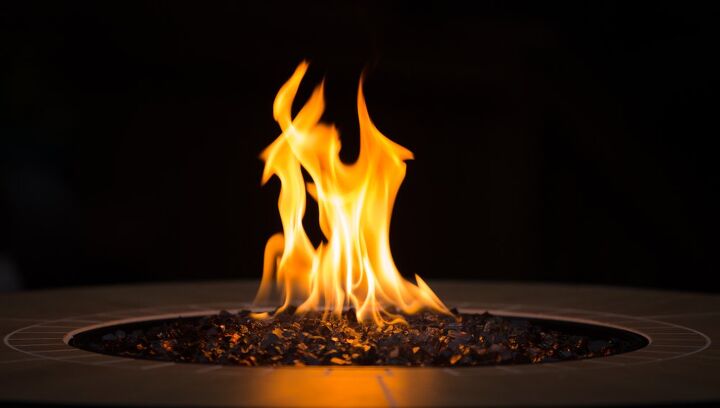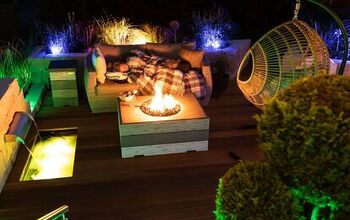Can You Put A Fire Pit On An Outdoor Rug? (Find Out Now!)

An outdoor rug is a great addition to a patio, and this fixture provides another means for a homeowner to express their style. But what about when there’s a fire pit on the patio? Can a rug go under this beloved patio fixture? Such is the question this article answers.
Yes, you can put a fire pit on top of or near an outdoor rug, so long as the fire pit is equipped with some kind of heat-reducing fixture. This could be a flame-retardant mat, a thick pad, a heat shield, or a brick foundation. When considering which measure of protection to purchase, you should also keep visual appeal in mind, as a lot of these safety measures are not visually attractive.
Can a Rug Go Under a Fire Pit?
Most rugs can be used under a fire pit, but some rugs should definitely be kept away from fire pits, particularly if the fire pit is made of wood. Even basic wood fire pits can emit considerable heat, and they also generate sparks, especially if the wood is dry.
If a spark hits a nearby rug—and the rug is made of a flammable material like straw—the rug could ignite, and such a situation is one no homeowner wants to deal with. After all, the patio should be enjoyed—not feared!
Installing a fire pit mat or pad directly under the fire pit will ensure the rug below doesn’t get too hot. But having a mat or pad under a wood fire pit may not look good.
In the end, one must find a fire pit that’s compatible with their current patio rugs, or vice versa. Otherwise, one fixture will have to be sacrificed for the other.
What Is a Fire Place Mat?
While there are several kinds of fire pit mats, the one that’ll be in focus here is the ember mat. As its name implies, this mat helps protect the ground below and around the fire pit from coming into contact with embers.
These mats are also flame-retardant, so there’s no need to worry about the mat melting or catching fire. They’re also cost-effective and moving them is easy. These are the positive qualities of fire place mats, but of course there are some downsides as well.
One notable downside is that a fire place mat won’t provide the best foundation. And if there’s no stability, then the fireplace could wobble and even tip over.
And remember that a fire pit mat isn’t meant to be a decoration. Therefore, if you’re trying to a create a visually attractive patio, it’s best to avoid installing a fire pit mat. There are, however, fire pit mat alternatives that one can pursue when they want both safety and visual appeal.
Reducing the Heat
Fire pits are seen as enjoyable outdoor fixtures by most, but they can become quite dangerous if they generate too much heat. This is why one should always be cognizant of how hot their fire pit is at all times, as too much heat can lead to a bunch of negative consequences. Here are some measures one can take to ensure their fire pit doesn’t generate too much heat.
Fire Place Shield
One can use a fire pit heat shield to reduce the amount of heat the fire pit generates. These shields are made of steel and aluminum, and they’re installed around fire pit foundations to protect whatever is below.
If you have a rug below one of these shields, you won’t have to worry about it getting burnt or ignited. While these are some of the main benefits of installing a fire pit heat shield, there are some cons, and these are listed below:
- Expensive
- Bulky
- Lacking visual appeal
If you’re a camper—and you take a mobile fire pit with you—then you know that fire pit heat shields are far from portable. Mobile fire pits don’t require these shields, and that’s because mobile fire pits run on propane. These propane-powered systems tend to generate less heat.
Installing a heat shield can cost anywhere from $70 to $200; the price largely depends on what kind of product you get and whether you install it yourself or hire someone to do this for you. While a heat shield is more stable than a mat, it also lacks visual appeal.
Brick & Tile Fire Pit Surfaces
Another good way to reduce the amount of heat a fire pit generates is creating a brick foundation. You could also use pavers here. Either setup is good, as with both you’ll have a strong foundation and an added layer of heat-resistance—all without sacrificing visual appeal.
This configuration really brings together the best of both worlds, as you’ll get a durable foundation along with endless possibilities to express your decor creativity. When one uses fire-resistant mortar and bricks to make their fire pit, an efficient work of art is typically the result.
There are some downsides though, with the main one being that it takes a lot of time and energy to build such a fire pit, especially if you’re doing this on your own. Therefore, if you want to ensure your fire pit is safe while also being visually appealing, it’s best to get an expert mason or bricklayer to create a fire pit for you. You can also hire a company that specializes in installing fire pits.
What About Propane-Powered Fire Pits?
Propane fire pits are ideal for those who don’t want to invest in additional heat-reducing measures. The majority of propane fire pits can be used on top of outdoor rugs, as most tend to not send heat downward. Of course, not all propane fire pits are like this, so you should always be vigilant when using a rug under a propane fire pit.
A good test is to run a propane fire pit for about 20 minutes. Next, shut the system off and then wait about two minutes. After the time is up, check the area around the fire pit to see how hot it is. If you don’t feel significant heat, take this as a sign that the propane fire pit won’t damage the rug.

Matt loves everything DIY. He has been learning and practicing different trades since he was a kid, and he's often the first one called when a friend or family member needs a helping hand at home. Matt loves to work with wood and stone, and landscaping is by far his most favorite pastime.
More by Matthew Mountain



























